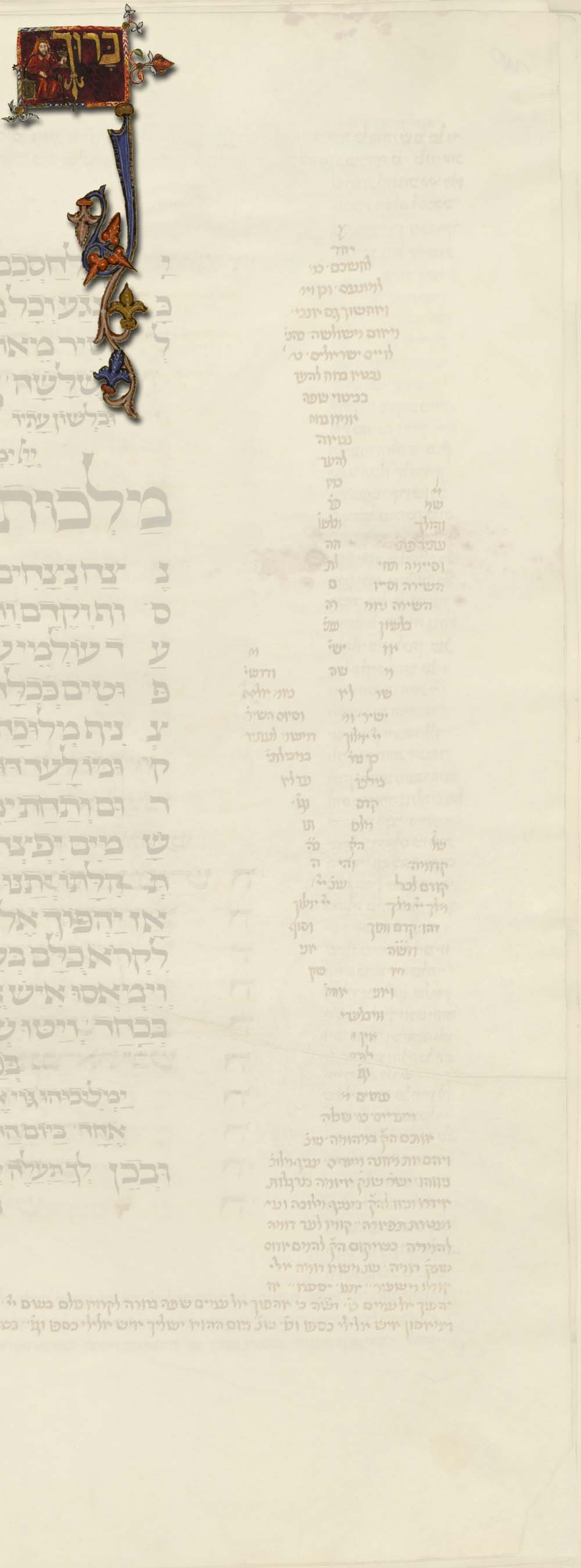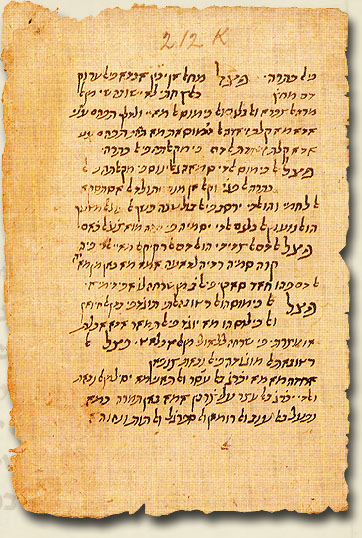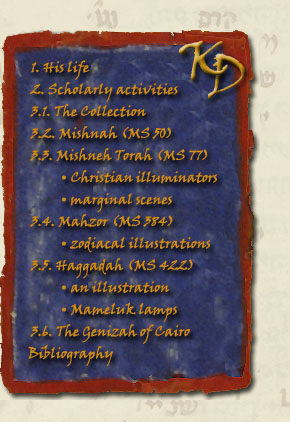


 3.5.
The Genizah of Cairo
3.5.
The Genizah of Cairo

 The shelf-marks MSS Kaufmann A 592, A
593 and A 594 indicate a collection of fragments from the Cairo Genizah, 210
approximately six-hundred fragments. A catalogue of them is soon to be published
within the framework of a joint project of our Oriental Collection and the
Institute of Microfilmed Hebrew Manuscripts in the Jewish National and
University Library in Jerusalem. The description of the items is now nearing its
completion by Ezra Chwat.
The shelf-marks MSS Kaufmann A 592, A
593 and A 594 indicate a collection of fragments from the Cairo Genizah, 210
approximately six-hundred fragments. A catalogue of them is soon to be published
within the framework of a joint project of our Oriental Collection and the
Institute of Microfilmed Hebrew Manuscripts in the Jewish National and
University Library in Jerusalem. The description of the items is now nearing its
completion by Ezra Chwat.
We do not know how Kaufmann acquired his fragments, he never wrote on this subject. 211 One of his students, Izidor Goldberger, tells us – and he may have heard this only from Kaufmann – that
He was among those who first wiped off the pitch-black dust of a thousand years from the papyrus leaves of the Cairo Genizah. And it was only the careless Hungarian connection that handed over these precious items to the University of Cambridge. The scholar's only consolation for the lost treasures was to admit that they went to a good place. 212
It is worth noting that
Goldberger is referring to a
Hungarian connection, while Kaufmann
uses the expression “Oriental friend” in his letter published by
Schmelzer in his contribution to
the present volume. Was he perhaps a Hungarian Jew?
Scheiber succeeded in tracing
Kaufmann’s letters to
Schechter in the possession of a
dealer in London in 1975, where some clues to the solution of this question
might have been found, but had no time to read them. 213
 Scheiber acquired xerocopies of
fifteen letters of Schechter
written in London and Cambridge between 24 November 1889 and 15 December 1898
and sent to Kaufmann to various
addresses in Budapest, Kojetein, Heringsdorf (Ostsee), Seebad Kolberg and
Karlsbad ([Hotel] Belle Alliance). From these it appears that a very friendly
relation existed between these two outstanding scholars.
Schechter regularly informed
Kaufmann of confidential matters.
When following the death of Schiller-Szinessy
the post of Reader in Rabbinic Literature became vacant at Cambridge University
and Schechter applied for it in 1890, he requested
Kaufmann for a letter of
recommendation, a “testimonial,” to attest his scholarly qualities and
achievements and recommend him to this post.
Kaufmann seems to have fulfilled
this request because somewhat later
Schechter thanked him most devotedly for the kind and appreciative
“testimonial.” Schechter supplied
Kaufmann also with data concerning
the family Gomperz. After the
discovery of the Genizah, Schechter
repeatedly informed Kaufmann of the
richness of the material. Kaufmann
seems to have requested Schechter
to send him fragments – probably for inspection – but
Schechter declined this request on the ground that the
Trustees would not agree to a dispatch of the fragments overseas. Now and then
Schechter requested copies of
passages from Kaufmann’s Mishnah
codex. There were also many complaints against Adolf
Neubauer, whom neither
Kaufmann nor
Schechter seemed to be particularly
fond of. 214
Both of them were very keen on that
Neubauer would not have the possibility of seeing the fragments from the
Genizah. Some letters are in the hand of the “secretary,” Mathilde S.
Schechter, Schechter’s
wife, who also wrote at least one very kind letter to
Kaufmann, whom he wished to get acquainted with so much
because she had heard so many good things about him from her husband. It is most
thrilling to read Schechter’s lines
on his progress in sifting the Genizah material at Cambridge. The reader is
reminded once again that no human being in this world is granted pure,
unadulterated happiness: going through the Genizah material
Schechter had to realize that a
considerable part was in Arabic, a language he was completely ignorant of. He
repeatedly complained to Kaufmann
that he did not understand a word of this portion of the Genizah and asked him
to go to Cambridge to help him.
Scheiber acquired xerocopies of
fifteen letters of Schechter
written in London and Cambridge between 24 November 1889 and 15 December 1898
and sent to Kaufmann to various
addresses in Budapest, Kojetein, Heringsdorf (Ostsee), Seebad Kolberg and
Karlsbad ([Hotel] Belle Alliance). From these it appears that a very friendly
relation existed between these two outstanding scholars.
Schechter regularly informed
Kaufmann of confidential matters.
When following the death of Schiller-Szinessy
the post of Reader in Rabbinic Literature became vacant at Cambridge University
and Schechter applied for it in 1890, he requested
Kaufmann for a letter of
recommendation, a “testimonial,” to attest his scholarly qualities and
achievements and recommend him to this post.
Kaufmann seems to have fulfilled
this request because somewhat later
Schechter thanked him most devotedly for the kind and appreciative
“testimonial.” Schechter supplied
Kaufmann also with data concerning
the family Gomperz. After the
discovery of the Genizah, Schechter
repeatedly informed Kaufmann of the
richness of the material. Kaufmann
seems to have requested Schechter
to send him fragments – probably for inspection – but
Schechter declined this request on the ground that the
Trustees would not agree to a dispatch of the fragments overseas. Now and then
Schechter requested copies of
passages from Kaufmann’s Mishnah
codex. There were also many complaints against Adolf
Neubauer, whom neither
Kaufmann nor
Schechter seemed to be particularly
fond of. 214
Both of them were very keen on that
Neubauer would not have the possibility of seeing the fragments from the
Genizah. Some letters are in the hand of the “secretary,” Mathilde S.
Schechter, Schechter’s
wife, who also wrote at least one very kind letter to
Kaufmann, whom he wished to get acquainted with so much
because she had heard so many good things about him from her husband. It is most
thrilling to read Schechter’s lines
on his progress in sifting the Genizah material at Cambridge. The reader is
reminded once again that no human being in this world is granted pure,
unadulterated happiness: going through the Genizah material
Schechter had to realize that a
considerable part was in Arabic, a language he was completely ignorant of. He
repeatedly complained to Kaufmann
that he did not understand a word of this portion of the Genizah and asked him
to go to Cambridge to help him.
Ludwig Blau recalled:
This treasure all but came to Budapest. The late David Kaufmann, professor at the Rabbinical Seminary, was negotiating for purchasing the complete geniza. He became deadly pale when he had learned that Schechter, who had travelled to Cairo for this purpose, had got it before him. 215
This item of information must also have come from Kaufmann. He also mentions this himself in a remarkable letter recently discovered and published in the present volume by Hermann I. Schmelzer of Sankt Gallen. Scheiber still saw a cardboard box with the inscription in Kaufmann’s hand: Aus der Genisa einer egyptischen Synagoge. Di[enstag]. 11. Dec. 1894. 216 This date precedes Schechter’s visit by two years.
Is it perhaps due to pure chance that the most important Genizah collection in the whole world is not kept in the Oriental Collection today?
210 See now Stefan C.
Reif: A Jewish archive
from Cairo. London 2000.
211
Scheiber Sándor [=Alexander
Scheiber]: A
Kaufmann-geniza kutatása és jelentősége. [=Research on the Kaufmann
Genizah and its importance.] In:
Scheiber Sándor:
Folklór és tárgytörténet. Budapest 1977-1984. III. 501-502.
Alexander Scheiber:
The Kaufmann-Genizah: Its importance for the world of scholarship.
In: Jubilee volume of the Oriental Collection 1951–1976. Papers
presented on the occasion of the 25th anniversary of the Oriental
Collection of the Library of the Hungarian Academy of Sciences. Ed.
by Éva Apor.
[Keleti Tanulmányok, 2]. Budapest 1978. 176-179.
212
Goldberger 1900. 19.
213
Scheiber 1977-1984. III.
501-502. Scheiber
1978. 176.
214 Cf.
Reif 2000. 74-78, 83, 240.
215
Blau Lajos [=Ludwig
Blau]: Fosztat városa,
Maimonides működésének színhelye. [=The city of Fustat, the stage of
Maimonides’ activities]. In: Magyar-Zsidó Szemle 1938. 57.
[Reprinted in:] Blau Lajos:
Zsidók és a világkultúra. [=Jews and world culture]. Ed. by János
Kőbányai. Budapest 1999.
331.
216 Alexander
Scheiber: Qetacim
hadašim mi-Sefer Talmuda rabba šel Yosef ben Yacaqob
ha-babli. In: Semitic studies in memory of Immanuel Löw. Ed.
by Alexander Scheiber.
Budapest 1947. 164 [Hebrew section].
Scheiber 1977-1984. III.
502. Scheiber 1978. 179.
